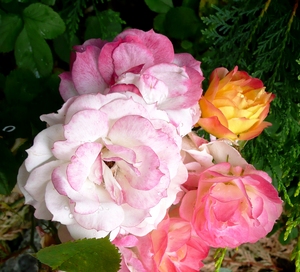Get the most blooms and best growth from your climbing roses with a little basic training. The secret to more flowers and better growth is to give them adequate support.
You may ask “why train roses?” The answer is simple, so that they grow upright. Climbing roses are not true climbers. They do not have tendrils or suction roots, so they cannot climb on their own. Help your climbing rose earn its name by training it to an erect form.
Left on their own, your climbing roses will sprawl across the ground. Some professional landscapers use climbers as flowering groundcovers on steep slopes and other places in the yard that are not used as walkways.
For maximum blooms, training involves bending the canes of the rose to make side shoots grow. The more shoots you help the rose produce, the more blooms it will yield. Training also includes thinning old or unproductive canes, enabling stronger, younger canes to produce more flowers.
The two steps to training a climbing rose are bending canes and pruning for renewed growth. As canes grow, bend them in arcs and tie them in place so that they grow horizontally or downward. Canes that grow straight up produce flowers only at their tips. The more you bend a cane, the more side shoots it will produce.
Prune to remove dead or straggly growth, and to trim healthy canes to a pleasing, attractive shape.
Climbing roses must grow for two to three years before they bloom. During this period, bend and tie canes in spring when they are at their most flexible. After the rose blooms, add pruning to the training procedure.
Climbers that bloom once a season should be pruned as soon as new growth appears in spring. Prune repeat bloomers after they have finished flowering.
Step one: Bending canes
You will need:
Climbing rose
Soft pliable ties
Support (trellis or wall)
Gloves
1. Plant the climbing rose about 30cm in front of a support. Position it with its roots pointing away from the support.
2. As canes grow, tie them to the support. Make the tie tight enough to hold the cane firmly, but loose enough for growth.
Professional plant ties are available at nurseries or garden centers. You can save the cost of buying these materials by using soft cloth strips or sections of soft twine. Never secure the canes with wire or other rigid fasteners, as they can damage the bark or strangle the rose as it grows.
3. Slowly flex the cane tip to the horizontal position when canes are long enough to bend in an arc. Tie the canes to the support.
4. Remove the flowers before they fade in the first season. Remove as little of the foliage and stem as possible.
Step two: Pruning canes
1. Cut out dead or old canes, leaving three to five young, healthy ones. Remove straggly or diseased growth.
2. Cut the side shoots so that there are only about 8-10 buds on the shoot. For the best appearance, prune lightly.
3. Remove suckers by digging down to where they attach to the main stem of the rose, and pulling them off.
Alternatives to climbers
Ramblers grow in much the same way as climbers do. The difference between the two is that ramblers have smaller flowers and usually bloom only once each season. They can be trained just like climbing roses, but must be pruned more severely to maintain an attractive form because they grow more vigorously.
Hybrid Tea, Floribunda, and Grandiflora Roses can all be trained as climbers. Their canes should be bent and tied in the same way, but unlike real climbing roses, these types can be pruned in winter.







